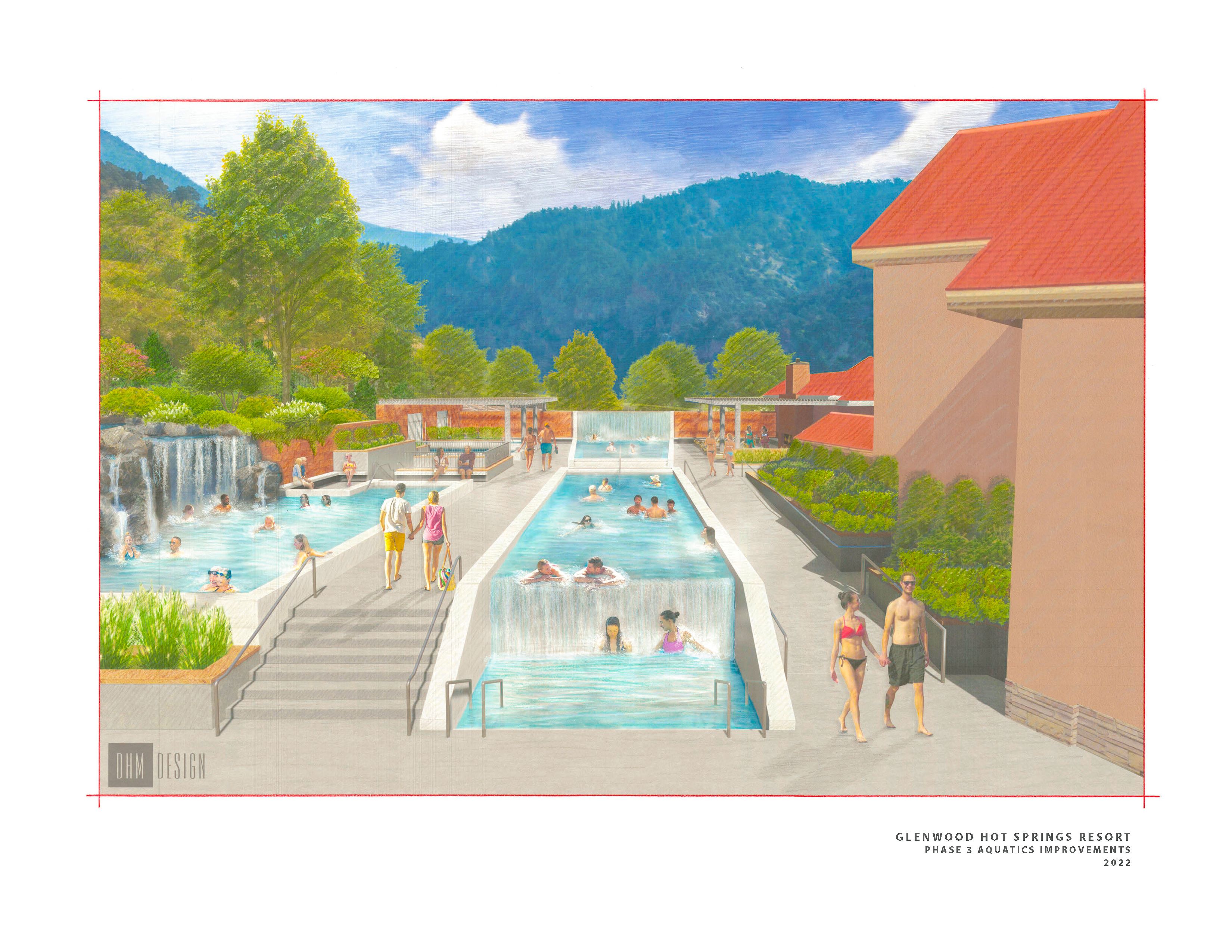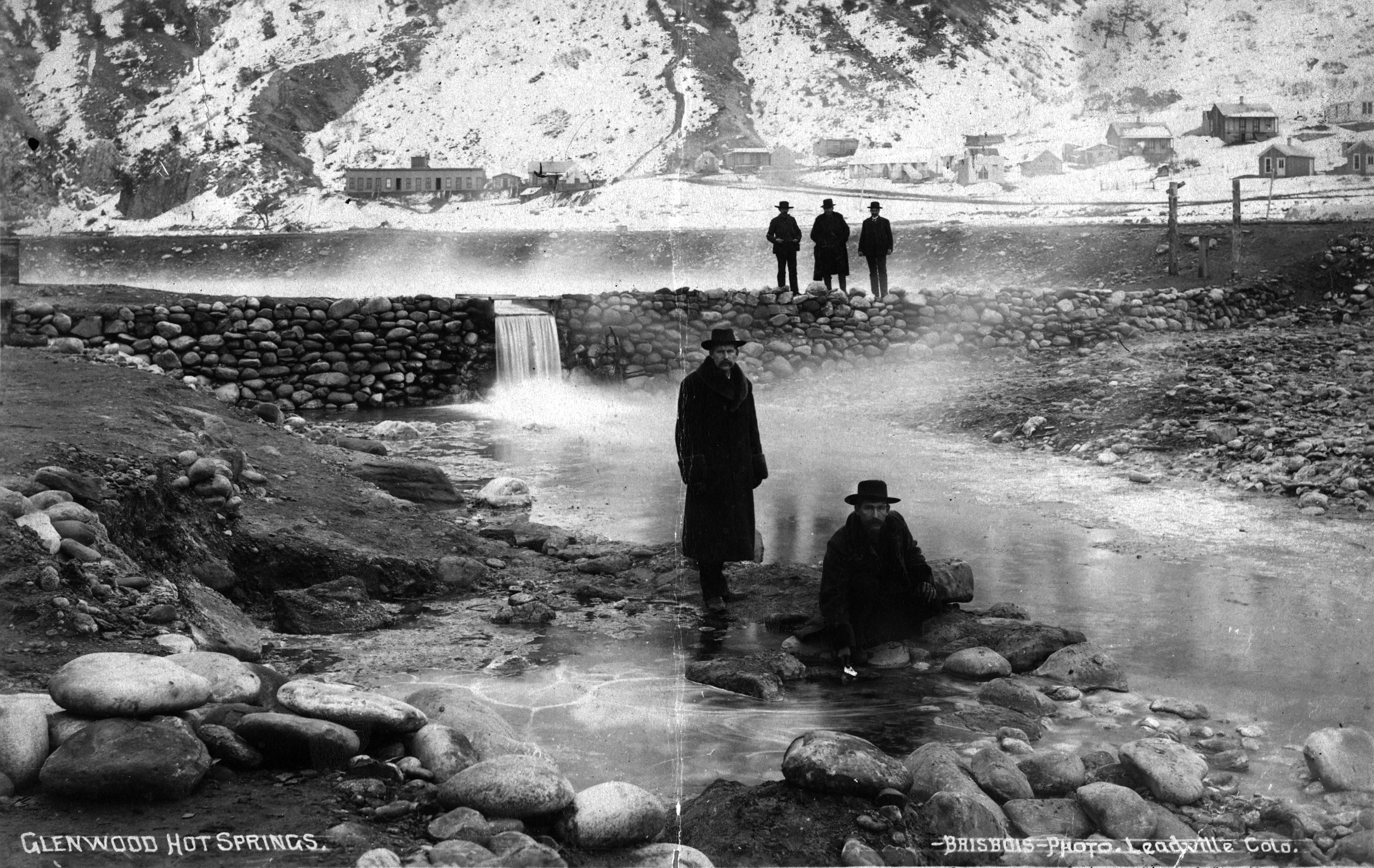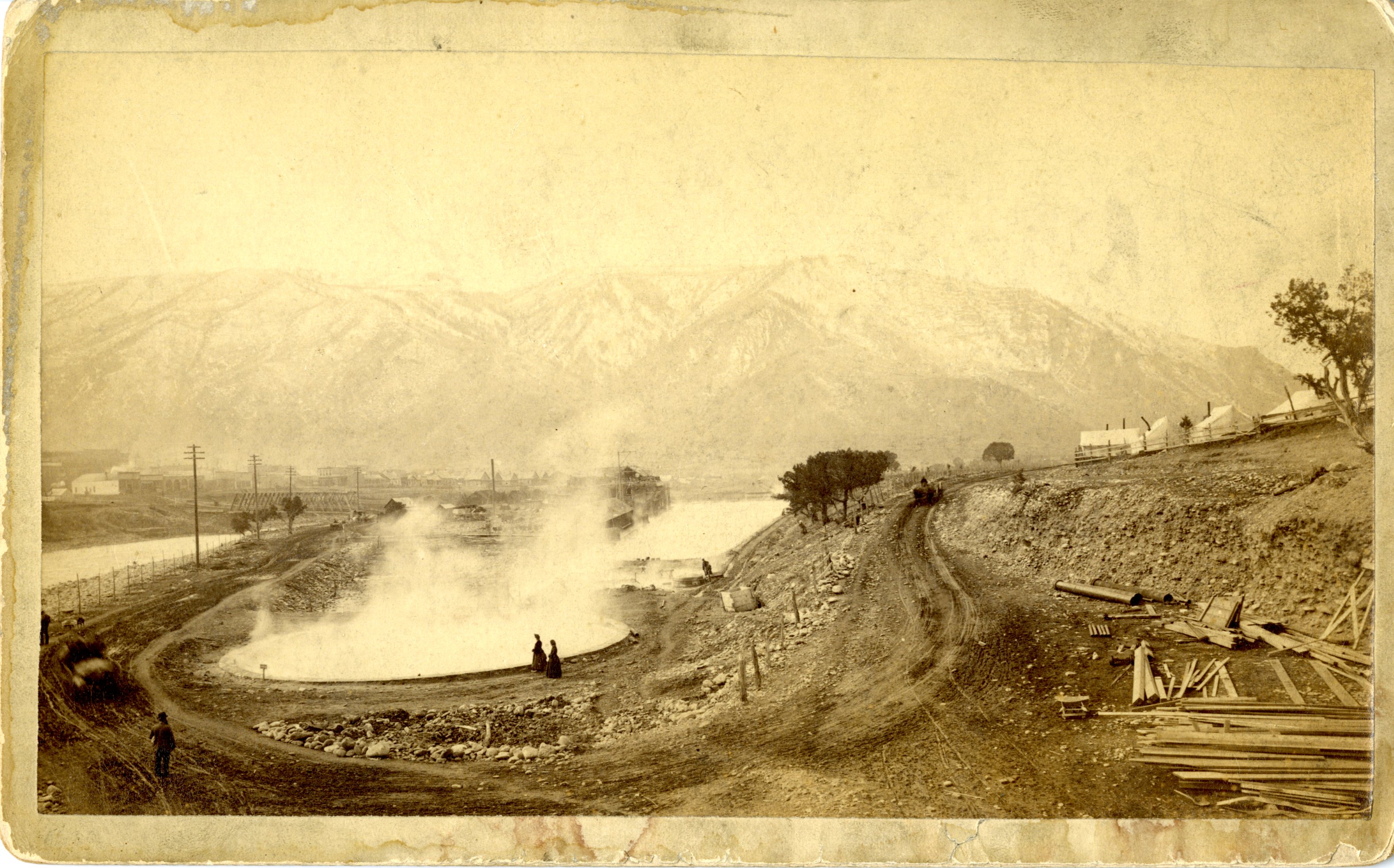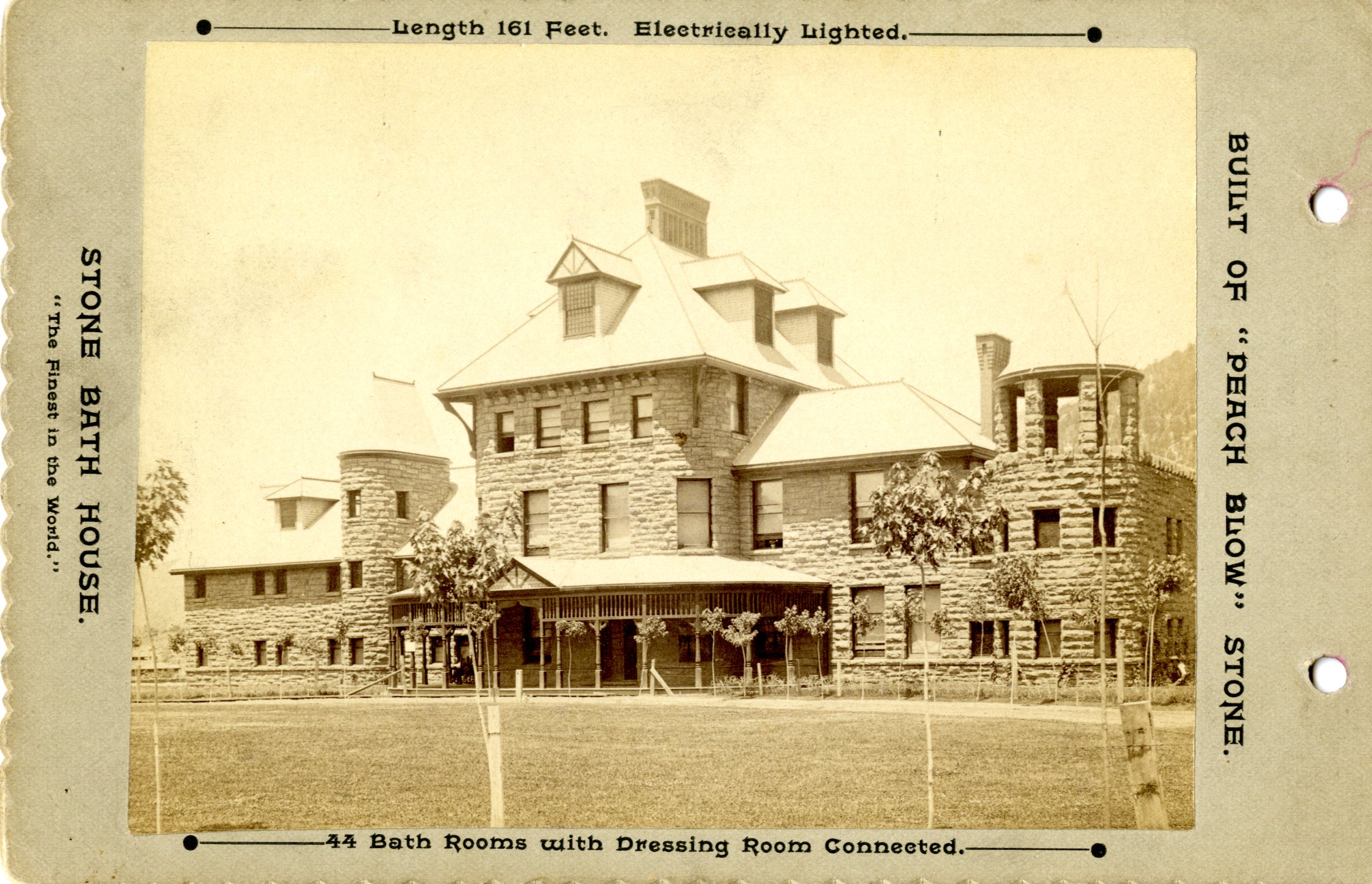A rowdy frontier town quickly becomes a world-renowned hot springs destination.
One of Colorado’s best-known historic attractions keeps getting better with time. Located on the site of the prolific Yampah Spring that produces 3.5 million gallons of pure mineral springs water a day, Glenwood Hot Springs Resort opened to great fanfare on July 4, 1888 in Glenwood Springs, Colorado.
However, longevity doesn’t mean static. the East End Expansion, due to open in late May, is the third phase of a multiyear plan that introduces new features, implements improvements, and continues good stewardship of the world’s largest hot springs pool. This entirely new swimming area, located on the east end, is designed for adults and has five additional pools of varying temperatures, a shade pergola, and an outdoor lounging area with a hearth. Two of the pools have soothing waterfalls, including one that provides a natural stone grotto experience.

As with the historic Grand Pool and Therapy Pool, the geothermally heated water for the new pools comes directly from Yampah Spring and features 15 naturally occurring minerals that soothe mind, body and spirit. The Ute people were some of the earliest discoverers of the health benefits of hot springs and named this spring Yampah, which means “big medicine.”
As part of the East End Expansion, the area around Yampah Spring is being landscaped, the historic drinking spring reopened, and signage installed to tell the story of this Glenwood Springs heritage property.
The first phase of Glenwood Hot Springs Resort’s multiyear improvement plan, Sopris Splash Zone, opened on the west end in 2019 to deliver a completely new experience for families, including a whitewater river tube ride, the lighted Grand Fountain that serves as a splash pad during the day, and a children’s pool with three small slides, waterfalls, shallow play areas and more. Phase two wrapped up in 2022 and included major upgrades to the Therapy Pool and all changing rooms. The fourth phase will be announced later this year.
Over the years, this Colorado hot springs resort has grown to include a 107-room lodge, full-service athletic club, gift shop, and poolside restaurant and snack bar. The resort is linked to downtown Glenwood Springs by a pedestrian bridge that borders the west end of the pool.
A step back in time
The Historically Landmarked & Significant Places booklet published in 2015 by the Glenwood Springs Historic Preservation Commission describes the community’s rich and colorful heritage and spotlights significant buildings and attractions such as Glenwood Hot Springs Resort. The following includes several excerpts from this insightful document.
For hundreds of years, the Ute Indians fought over and protected a sacred spot at the confluence of the Rio Grande de Buena Esperanza (Colorado) and Bunkara (Roaring Fork) rivers. Next to an island in the middle of the river and at the western end of a magnificent canyon, hot thermal water rich in minerals flowed. The flowing hot water also created a natural sauna in a series of caves. The Ute people came to this place to rest, hunt, fish and utilize the healing powers of the hot springs.
In 1860, Captain Richard Sopris and a party of geologic explorers noticed Yampah hot spring and named the place Grand Springs. Permanent settlements in the area started to pop up in 1880. In 1881, James Landis homesteaded 160 acres that included most of the hot springs area.

Isaac Cooper at the source spring standing at the center of the photo.
Landis sold the acreage to Captain Isaac Cooper, a Civil War veteran who came to the area in 1882 and dreamt of turning the hot springs into a health spa. He formed a company called the Defiance Town and Land Co. of Colorado, acquired 400 acres of land, and began to survey a town site that he named Defiance. In 1885, the name was changed to Glenwood Springs, after his hometown of Glenwood, Iowa.
The fascinating history of Glenwood Hot Springs Resort begins in 1886 when Walter Devereux, an engineer and silver baron, and his two brothers bought Yampah Spring and 10 acres of land from Cooper. The spring was located on an island situated in the Colorado River. The plan to build the world’s largest hot springs pool began by diverting the natural flow of the Colorado River to the south side of the mid-river island. Construction of the stone diversion wall began in 1886 and building of the aqueduct and pool commenced in early 1888.

The walls of both the pool and the bathhouse were built of Peachblow sandstone from a quarry along the Frying Pan River near Basalt. The Richardson Romanesque-style bathhouse featured 42 sunken Roman vapor baths made of imported porcelain tubs (30 for men and 12 for women), women’s and men’s parlors, a physician’s office, a gymnasium, and smoking and reading rooms. The top floor was an exclusive casino for men. The facility, considered the largest and most lavish in Colorado at the time, was built at a cost of $100,000.

The swimming pool was excavated from the original riverbed along the north edge of the island and paved with fire brick. Measuring in at 615 feet by 75 feet, the pool set a world record. A small wooden bathhouse was constructed at the west end of the pool for use by the general public and demolished many years ago.
Also in the early days, an inhalatorium was built on the east side of the springs. Wicker chairs were provided inside the screened-in wooden building for tourists and patrons who wanted to breathe in the warm vapor. Later called Cocktail Spring, health-seekers drank the water for its healthful benefits.
As part of the plan to transform Glenwood Springs into a world-renowned healing center in the mountains, Glenwood Hot Springs Company led by Walter Devereux hatched the idea to build a grand hotel in the early 1890s. Funded by local, East Coast and British investors, construction of Hotel Colorado began in 1891 with the property’s Italianate architecture modeled after the Villa de Medici in Italy and designed by New York architects Boring, Tilton & Mellon. Opening across from the pool in 1893, no expense was spared with features like a 185-foot-tall water fountain in the courtyard, Victorian garden, bird sanctuary, indoor waterfall, and tennis courts.
Isaac and Devereux also embarked on civic projects that brought water, electricity and railroads to Glenwood Springs. Near the north end of today’s Grand Avenue, Devereux erected a coal-fired, steam-driven electric power plant, making Glenwood Springs one of the first towns in Colorado to be supplied with commercially available electricity starting in 1886.
Glenwood Springs was growing, and the need for more electric power was evident. Devereux and his British financiers erected a hydroelectric plant next, and Glenwood Springs received its first hydroelectrically generated power through Glenwood Light and Water Company in 1888. The City of Glenwood Springs purchased the company and hydroelectric plant building in 1947.
The D&RG and Colorado Midland Railroad both began railroad service to Glenwood Springs in 1887, both striving to be the first. The local economy also was fueled by coal mining, commerce, outdoor recreation, farming and ranching. The annual Strawberry Festival stretches back to 1898.
As word of the new hot springs pool, grand hotel and growing community spread, wealthy Victorians, aristocrats, political leaders, movie stars and spiritual believers ventured to Glenwood Springs from around the world.
Fast Forward
During World War II, from 1943 to 1946, the hot springs pool and Hotel Colorado were used exclusively as a U.S. Naval Convalescent Hospital to provide a place for sailors to recuperate. Hotel Colorado had a 500-bed patient capacity and assisted 6,525 veterans on their journey back to health. After the war and until the early 1950s, the hotel was converted into a private hospital, Glenwood Clinic. Since then, there have been a variety of owners of Hotel Colorado, the most recent being the Melville family who purchased the property in 2018.
Jumping back a bit, Frank Kistler purchased the pool in 1938 and sold it to a group of local businessmen in 1954; their families continue to operate Glenwood Hot Springs Resort today. These new owners begin massive renovations to the property including enlarging the Grand Pool and creating the smaller and warmer Therapy Pool. Glenwood Hot Springs Athletic Club opened in the 1980s, and Glenwood Hot Springs Lodge welcomed its first guests in 1986. A heat exchanger device was installed in 1994 to harness the geothermal energy for snowmelt systems and heating domestic water supplies for the lodge and bathhouse, making it one of the first truly sustainable resorts in Colorado.
In 2000, the resort added two water slides and a miniature golf course at the west end of the pool that were replaced by Sopris Splash Zone in 2019, which launched the most recent multiyear phase of improvements as described earlier.
Learn More About Glenwood Springs History
The Glenwood Springs Historical Society has two locations to explore in Glenwood Springs: Frontier Museum, a furnished 1905 Victorian-style home at 1001 Colorado Ave., and the Doc Holliday Collection located on the lower level of Bullocks Western Wear at 732 Grand Ave.
Download the Walking Tour Guide of Historic Glenwood Springs by Glenwood Springs Historical Society to check out other historic sites and read about the history of Glenwood Hot Springs Resort and Hotel Colorado. There are many interesting facts and colorful characters from a rowdy frontier town that aptly started out with the name Defiance and by 1883 was full of miners, trappers, traders, gunslingers, prostitutes and other citizens.
Today, the community and Glenwood Hot Springs Resort beautifully meld past and present. The vision continues to focus on maximizing enjoyment for generations of locals and guests who will visit and relax in the revitalizing hot spring waters now and in the future.